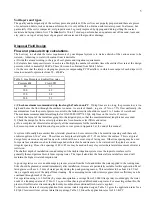
7
Beware of high points and siphoning and slopes.
A potential problem with buried drip lines is siphoning dirt in when the system is switched off. For this reason:
a) Drip lines should have a fairly constant slope. If possible run lines along a contour.
b) A vacuum breaker valve should be provided at the highest point in each sector.
c) Check actual flows against maximum available flow rate and if necessary break the system into sectors to divide the
flow. Here is where solenoid valves and irrigation controllers become useful.
d) Drip lines should be connected at the end to a common flush line with a flush valve / vacuum breaker.
e) Avoid installing lines along rolling hills where you have high and low points along the same line. If this is the case,
connect all the high points together and install a vacuum breaker valve.
Slopes.
When designing on a slope the dripperlines should follow the contour. If slopes are more than 2 m then:
1) Each dripline lateral should have it’s own individual pressure reducing valve fitted, with flushing valve at the end of
each lateral, or
2) Pressure Compensating Wasteflow™ dripline should be used
Beware of excessive level differences.
Unless the system is designed with individual line pressure regulators, level differences between drip lines belonging to the
same valve, should not exceed 2 m.
Interconnect long parallel lines in the middle.
This practice improves the uniformity of the system and helps to avoid siphoning dirt into the system when there is a
broken line. Two tees can be used.
Positioning of vacuum breaker / flush valves.
Ensure that these valves are at a point high enough to prevent the system from draining through these valves when the
water pressure is switched off.
Mounds
.
Concentrate drip lines at the top of the mounds with wider spacing towards the bottom. In the case of compound slopes
consult a professional irrigation designer.
Pressure regulator bypass.
It is useful to have a pressure regulator bypass as shown in Diagram 1, in order to increase pressure for flushing and for
breaking through any blockage which may occur in the drippers themselves.
4. SYSTEM INSTALLATION
Installation Guidelines
WARNING: ROOTGUARD® is temperature sensitive. To assure a long protection life, store the drip line under shade in
a cool place. Avoid hot temperature extremes.
a) Prepare the soil to get the best water saving results with the system. Excavation, filling and grading should have been
finished before installation of the subsurface drip system.
b) Be sure you have everything required for the installation before opening trenches. Preassemble as many sets of
components as practical above ground and in a comfortable place. Submain and flushing manifolds can be fabricated
beforehand, with the holes required for drip tube grommet or barbed fittings pre-drilled. The submain manifold with tees
can be preassembled and used to mark the beginning and end of WASTEFLOW™, etc. Do not start opening trenches until
you are sure you have all the materials required.






























